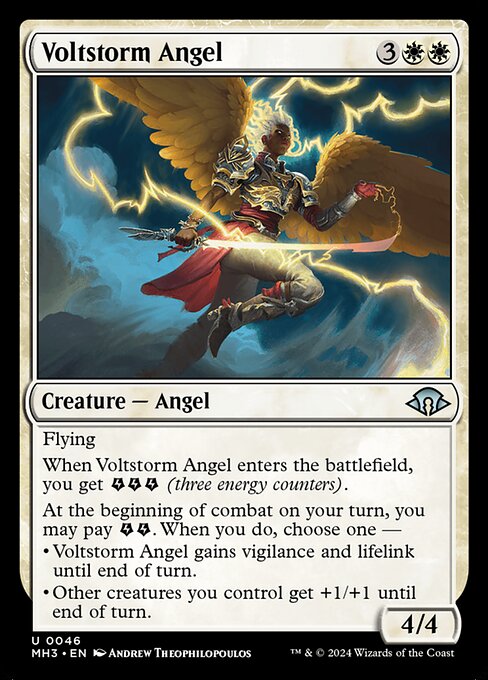
Image courtesy of Scryfall.com
Rarity and Mana Cost in MTG: A Voltstorm Angel Case Study
Magic: The Gathering has always walked a fine line between raw power and the narrative weight of rarity. When you pull a card with a flashy five-mana commitment and an equally flashy wingspan, you expect it to earn its place on the battlefield and in your collection. Voltstorm Angel, a creature from Modern Horizons 3, gives us a pristine example of how rarity can sit in an unusual sweet spot relative to mana cost 🧙♂️🔥💎. It’s a white, flying 4/4 that costs {3}{W}{W}, yet it lands as an uncommon in a set known for draft innovations. The design behind this card invites us to rethink whether “more mana equals rarer” is still a reliable rule of thumb in the age of utility and flexibility.
From a glance, three white mana and two colorless mana seems like a mid-to-late-game investment, especially for a 4/4 flyer. In a vacuum, that’s a respectable stat line, but Voltstorm Angel doesn’t stop there. When it enters the battlefield, you gain three energy counters, a nod to the Kaladesh lineage of energy—where resources like these shape tempo and value over multiple turns. The card’s true flavor comes online at the moment you start tapping energy: at the beginning of combat on your turn, you may pay {E}{E} to choose one of two powerful options. You can grant this creature vigilance and lifelink until end of turn, turning a robust flyer into a resilient attacker that also sustains you in the face of blockers. Or you can boost all your other creatures by +1/+1 until end of turn, creating a temporary swarm that can overwhelm an opponent before they draw their next trick. That flexibility is the heartbeat of the card’s design, and it’s a big part of why an uncommon card can feel deceptively potent for players who know how to navigate energy resources ⚔️🎨.
What Voltstorm Angel reveals about design, rarity, and power
Let’s break down the core elements that inform its rarity and mana cost pairing. The card is white, with the keyword Flying, a creature type that typically enjoys premium stats or game-altering effects in five-mana space—but Voltstorm Angel earns its keep with enter-the-battlefield energy that powers two distinct one-turn options. The rarity of uncommon here reflects a few key decisions:
- Mana cost and board impact: At five mana total, Voltstorm Angel sits in a gray area where the body (4/4) is solid but not explosive, and the activation options add a burst of utility rather than a lasting, game-ending effect. This keeps its power level in check for uncommon status, while still delivering meaningful board presence.
- Energy as a design constraint: The energy counters introduce a dynamic resource that players must manage. The requirement to pay {E}{E} to access one of two temporary effects creates interesting decision points, especially in draft or cube environments where energy engines and synergy cards (like Energy Reserve) can appear across colors. Rarity is a tool here—keeping the card uncommon helps preserve balance while encouraging creativity with energy cycles.
- Tempo vs. long-term value: The options reward decisive play (vigilance + lifelink on offense, or a temporary boost to the team). That tempo swing is the kind of engagement that fits an uncommon card—the potential is high, but the costs and timing are carefully constrained.
- Aesthetic and lore alignment: White’s themes of protection, life, and efficient combat align with lifelink and vigilance. Pairing these with a big, energy-driven activation fits the want for memorable, color-coordinated design in Modern Horizons 3’s “draft innovation” space. The card’s rarity mirrors the balance between a strong but not game-ending effect and a highly situational resource mechanic.
For players who love to theorycraft, Voltstorm Angel shines as a case study in how a five-mana body can deliver more than just combat stats. Its enter-the-battlefield energy provides a soft ramp in the sense that a turn or two later you could pivot into a decisive play by choosing the right activation. In formats that emphasize longer games, the card rewards careful energy management and timing—an evergreen reminder that rarity isn’t merely about raw power but about how a card interacts with the wider ecosystem of its set and the engine around it 🧙♂️💎.
Designer notes and the card’s set context hint at a broader trend: when a set experiments with new mechanics or revisits an older one (like energy), rarity can be used to gate complexity. Voltstorm Angel sits at uncommon, not because it’s underpowered, but because its most valuable essence is the decision-making it invites and the tempo swings it enables. And in the long arc of MTG history, that balance—between cost, body, and a flexible toolset—helps keep the game fresh for veterans and newcomers alike 🔥⚔️.
Speaking to collectors and players who love art and lore, Modern Horizons 3 also carries strong flavor—Andrew Theophilopoulos lends a crystalline, radiant aesthetic to Voltstorm Angel that underscores its role as a spark of energy in a battleground of white-aligned strategy. If you appreciate how art and mechanics converge, this card is a small, shining example of how Wizards of the Coast threads story through numbers and keywords 🎨💎.
On the practical side, if you’re keen to keep MTG vibes close throughout your day, Digital Vault’s cross-promotional gear—like a Phone Case with Card Holder MagSafe—offers a stylish way to carry references to your favorite cards on the go. It’s a neat reminder that the energy you invest in a card can translate into real-world joy as you swap decks, compare notes with friends, or simply display your nerdy pride in a handy, portable form. Check it out here and bring a splash of MTG whimsy into daily life.
Phone Case with Card Holder MagSafe